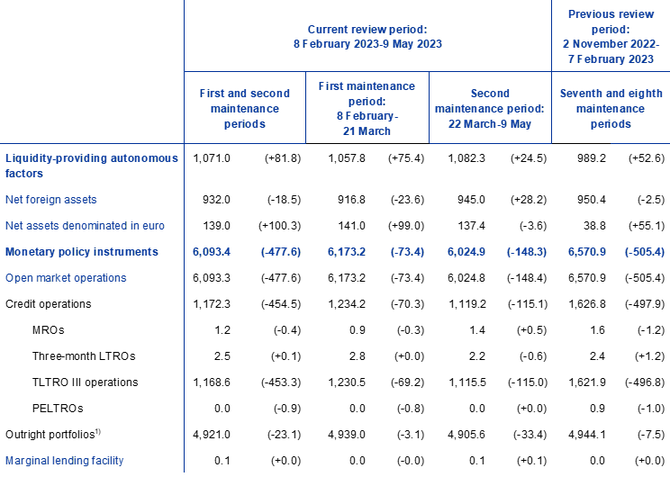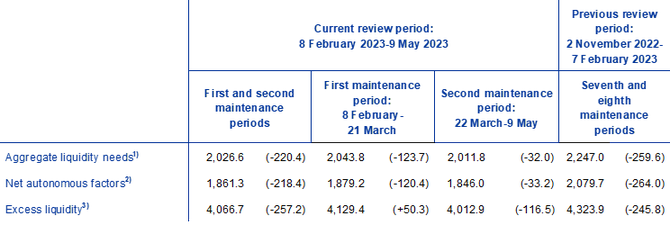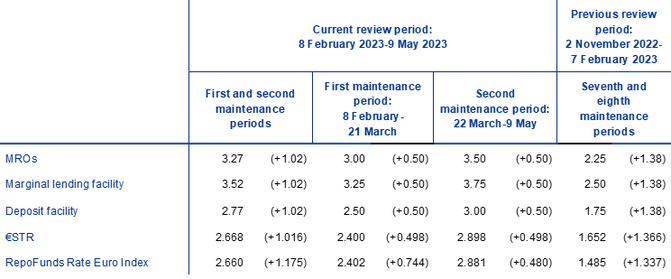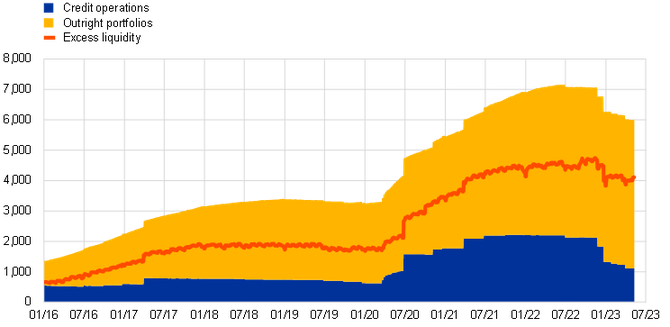Liquidity conditions and monetary policy operations from 8 February to 9 May 2023
Liquidity conditions and monetary policy operations from 8 February to 9 May 2023
Prepared by Jens Budde and Vladimir Tsonchev
Published as part of the ECB Economic Bulletin, Issue 4/2023.
This box describes liquidity conditions and the Eurosystem’s monetary policy operations during the first and second reserve maintenance periods of 2023. Together, these two maintenance periods ran from 8 February to 9 May 2023 (the “review period”).
Policy tightening continued during the review period. The ECB’s Governing Council raised its three policy rates by 50 basis points at each of the Governing Council meetings on 2 February 2023 and 16 March 2023.These increases took effect in the first and second reserve maintenance periods of 2023 respectively.
Excess liquidity in the euro area banking system declined during the review period. This decrease was mainly owing to early repayments and maturities under the third series of targeted longer-term refinancing operations (TLTRO III), coupled with a gradual decline in the size of the asset purchase programme (APP) portfolio. At the same time, the continued decline in net autonomous factors added liquidity to the system. Net autonomous factors have been continuing to fall since the end of the negative interest rate environment in July 2022.
Liquidity needs
The average daily liquidity needs of the banking system, defined as the sum of net autonomous factors and reserve requirements, decreased by €220.4 billion to €2,026.6 billion in the review period. When compared to the seventh and eighth maintenance periods of 2022, this decrease was almost entirely due to a fall of €218.4 billion in net autonomous factors, to €1,861.3 billion, driven by a decline in liquidity-absorbing autonomous factors (see the section of Table A entitled “Other liquidity-based information”) and an increase in liquidity-providing autonomous factors. Minimum reserve requirements declined marginally by €2 billion to €165.3 billion.
Liquidity-absorbing autonomous factors decreased by €136.5 billion to €2,932 billion in the review period, mainly owing to a decline in government deposits and other autonomous factors. Government deposits (see the section of Table A entitled “Liabilities”) fell on average by €62.9 billion over the review period to €369.7 billion, with most of the decline taking place in the second maintenance period. This decline reflects a normalisation in the buffers held by national treasuries and a likely adjustment in their cash management strategies in anticipation of the lower ceiling for the remuneration of government deposits by the national central banks that took effect on 1 May 2023. After 1 May, government deposits declined further to below €300 billion towards the levels of early 2020, before the onset of the pandemic. The average value of banknotes in circulation decreased by €6.1 billion over the review period to €1,557.1 billion. The reduction in banknote holdings and the amount of vault cash observed since the end of the negative interest rate environment continued during the review period, albeit at a considerably slower pace.
Liquidity-providing autonomous factors increased by €81.8 billion to stand at €1,071 billion. While net foreign assets decreased by €18.5 billion, net assets denominated in euro increased by €100.3 billion in the review period. This increase was largely the result of a fall in the liabilities to non-euro area residents denominated in euro. This in turn reflects an adjustment in the cash management strategies of account holders under the Eurosystem reserve management services (ERMS), since the remuneration of deposits held under the ERMS framework was adjusted alongside that of government deposits.
Table A provides an overview of the autonomous factors discussed above and their changes.[1]
Table A
Eurosystem liquidity conditions
Liabilities
(averages; EUR billions)

Source: ECB.
Notes: All figures in the table are rounded to the nearest €0.1 billion. Figures in brackets denote the change from the previous review or maintenance period.
1) Computed as the sum of the revaluation accounts, other claims and liabilities of euro area residents, capital and reserves.
2) Memo item that does not appear on the Eurosystem balance sheet and should therefore not be included in the calculation of total liabilities.
Assets
(averages; EUR billions)

Source: ECB.
Notes: All figures in the table are rounded to the nearest €0.1 billion. Figures in brackets denote the change from the previous review or maintenance period. “MROs” denotes main refinancing operations, “LTROs” denotes longer-term refinancing operations, and “PELTROs” denotes pandemic emergency longer-term refinancing operations.
1) With the discontinuation of net asset purchases, the individual breakdown of outright portfolios is no longer shown.
Other liquidity-based information
(averages; EUR billions)

Source: ECB.
Notes: All figures in the table are rounded to the nearest €0.1 billion. Figures in brackets denote the change from the previous review or maintenance period.
1) Computed as the sum of net autonomous factors and minimum reserve requirements.
2) Computed as the difference between autonomous liquidity factors on the liabilities side and autonomous liquidity factors on the assets side. For the purposes of this table, items in the course of settlement are also added to net autonomous factors.
3) Computed as the sum of current accounts above minimum reserve requirements and the recourse to the deposit facility minus the recourse to the marginal lending facility.
Interest rate developments
(averages; percentages and percentage points)

Source: ECB.
Notes: Figures in brackets denote the change in percentage points from the previous review or maintenance period. The €STR is the euro short-term rate.
Liquidity provided through monetary policy instruments
The average amount of liquidity provided through monetary policy instruments decreased by €477.6 billion to €6,093.4 billion during the review period (Chart A). The reduction in liquidity was primarily driven by a decline in credit operations. Net asset purchases under the ECB’s pandemic emergency purchase programme were discontinued at the end of March 2022; since then the Eurosystem fully reinvests maturing amounts. As regards the APP, in line with the decision of the ECB’s Governing Council not to reinvest all of the principal payments from maturing securities as of 1 March 2023, the APP holdings have begun to gradually decline at an average pace of €15 billion per month.[2]
Chart A
Changes in liquidity provided through open market operations and excess liquidity
(EUR billions)

The average amount of liquidity provided through credit operations decreased by €454.5 billion during the review period. This decrease largely reflects the decline in outstanding TLTRO III amounts owing to early repayments and maturities. The voluntary early repayments in February and March 2023 amounted to €36.6 billion and €87.7 billion, respectively, and the maturing of TLTRO III amounts in March led to a further decline in outstanding TLTRO III amounts of €32.2 billion. The TLTRO III repayments of €499.4 billion and €62.7 billion in December 2022 and January 2023, respectively, also contributed to this decline during the review period, as their full effect on the change in review period averages only materialise in the current review period. Changes in other credit operations were minor.
Excess liquidity
Average excess liquidity decreased by €257.2 billion to stand at €4,066.7 billion (Chart A). Excess liquidity is the sum of banks’ reserves above the reserve requirements and the recourse to the deposit facility net of the recourse to the marginal lending facility. It reflects the difference between the total liquidity provided to the banking system and banks’ liquidity needs. After peaking in September 2022 (€4.8 trillion), excess liquidity has progressively decreased, mainly following the aforementioned TLTRO III early repayments and maturities, net of the effects of autonomous factors.
Interest rate developments
The euro short-term rate (€STR) increased by 99.2 basis points, from 1.90% on 7 February, the last day of the previous review period, to 2.89% on 9 May, the last day of this review period, reflecting the ECB’s monetary policy tightening. The pass-through of the ECB policy rate hikes in February and March 2023 to the unsecured money market was complete and immediate. On average, the €STR traded at 10 basis points below the deposit facility rate during the current review period, similarly to the seventh and eighth maintenance periods of 2022.
The euro area repo rate, as measured by the RepoFunds Rate Euro Index, increased by 98 basis points, from 1.90% on 7 February to 2.88% on 16 March. The pass-through of the increases in the ECB’s policy rates to the secured money market was immediate and complete. The functioning of the repo market remained orderly owing to several factors, including measures taken by some national debt management offices at the end of 2022, an increase in securities lending limits, higher net issuances since the beginning of 2023 and the release of mobilised collateral on the back of the maturing TLTROs, as well as a decline in the outstanding APP holdings. Moreover, on 7 February 2023, the ECB announced that the ceiling for the remuneration of euro area government deposits with the Eurosystem would be set at a level of 20 basis points below the €STR as of 1 May 2023 and that the remuneration of deposits held under the ERMS framework would also be adjusted accordingly. The announcement alleviated concerns that this remuneration ceiling could return to 0% once the temporary ceiling had expired on 30 April 2023, thus minimising the risk of adverse effects on market functioning as a result of abrupt shifts in cash investments from national treasuries and foreign central banks.
For further details on autonomous factors, see the article entitled “The liquidity management of the ECB,” Monthly Bulletin, ECB, May 2002.
Securities held in the outright portfolios are carried at amortised cost and revalued at the end of each quarter, which also has an impact on the total averages and the changes in the outright portfolios.
